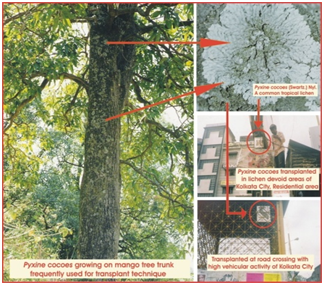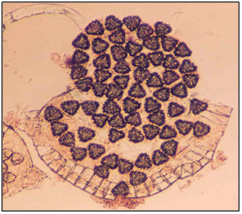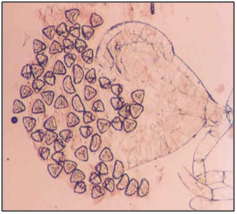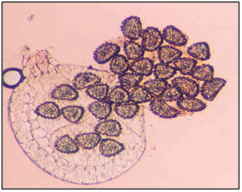Plants as Monitor of Pollution
Biomonitoring is one of the cost-effective and simple ways for investing the environmental quality and refers to process that uses living organisms to obtain quantitative information on environmental quality. Bioindicators and bioaccumulators that provide quantitative information on levels of pollution and allow the identification of change in the course of time are defined as “biomonitors”. Some of the essential characteristics of biomonitors are:
- The organism must be capable of accumulating metals in measurable amounts.
- The organism or the relevant part of it, must be readily available, in terms of quality and distribution, to make unbiased sampling possible.
- The study must be repeatable.
- The cost of collection and analysis should be acceptable.
The aim of this study was to investigate the possibility of monitoring pollution using biomonitoring potential of lower plants – lichens, bryophytes, pteridophytes and algae.
Bryophytes
With the objective to find out the bioindicator species of Bryophytes in the Mussoorie (Uttaranchal) for monitoring the air pollution at the spots of heavy automobile traffic movement, a preliminary survey of the Bryophyte Herbarium specimens collected from different localities of Mussoorie have been carried out. It has been critically observed that a thalloid liverwort Plagiochasma appendiculatum L. et L. is the most commonly and luxuriantly growing taxon at nearly all the sites surveyed.
Beside P. appendiculatum other liverwort found was Marchantia paleacea Bertol. A moss Mnium marginatum (With.) P. Beauv. was also growing luxuriantly in these areas. The heavy metal analysis revealed a fair amount of Pb, Cu, Zn, Ni, and Mn accumulation in the samples (P. appendiculatum and M. marginatum) collected from different areas. These observations have been validated in control laboratory experiment exposing the plants to different concentrations of load (Nath et al., 2011).
Source: plus.google.com
P. appendiculatum
Source: plants.usda.gov900
M. marginatum
Heavy metal content in the bryophytes collected from different places at Mussoorie
| S.N. |
Locality |
Plant’s Name |
Pb |
Cu |
Zn |
Ni |
Mn |
| 1 |
On way to Kempty fall near Taxi Stand |
P.appendiculatum |
55.63 |
28.86 |
63.53 |
5.5 |
177.06 |
| 2 |
On way to Kempty fall |
P.appendiculatum |
17.95 |
40.05 |
107.55 |
2.05 |
197.52 |
| 3 |
On way to Kempty fall |
P.appendiculatum |
26.19 |
29.22 |
84.30 |
6.61 |
142.38 |
| 4 |
1m from Kempty fall taxi stand |
Marchantiapaleacea |
11.46 |
15.63 |
97.30 |
2.25 |
45.90 |
| 5 |
Wood Stock college |
P.appendiculatum |
24.44 |
18.75 |
318.75 |
19.1 |
351.82 |
| 6 |
Lal Tibba |
P.appendiculatum |
11.52 |
20.55 |
116.70 |
6.93 |
152.33 |
| 7 |
Company Garden (Site 1) |
P.appendiculatum |
12.86 |
17.32 |
76.65 |
1.26 |
116.15 |
| 8 |
Company Garden (Site 1) |
Mnium marginatum |
19.62 |
34.34 |
239.70 |
17 |
237.48 |
| 9 |
Company Garden (Site 2) |
Mnium marginatum |
21.28 |
19.84 |
239.84 |
69.15 |
239.54 |
| 10 |
Company Garden (Site 2) |
P.appendiculatum |
13.92 |
34.23 |
105.30 |
19.95 |
200.49 |
| 11 |
Camel’s back Road |
P.appendiculatum |
48.15 |
25.13 |
249.70 |
26.7 |
113.64 |
| 12 |
Camel’s back Road |
Mnium marginatum |
58.68 |
27.92 |
353.66 |
13.65 |
276.36 |
Lichens

Occurrences of 26 species of lichens belonging to 13 genera and 9 families from 19 localities of Kolkata City and Indian Botanic Garden (IBG), Howrah, were reported. The lichen flora of IBG is compared to an earlier enumeration of lichens collected by Kurz in 1865 and described by Nylander in 1867s. It is interesting to note that in the last more than 140 years the lichen flora of the area has changed significantly, as only three species are common between the two studies. The reason for the change in the lichen flora of the area may be attributed to the microclimatic changes in the area due to fast pace of urbanization together with air pollution around the IBG and Kolkata City. Out of total 26 species of lichens only Arthonia tumidula, Bacidea rubella and Cryptothecia lunulata were common between IBG and Kolkata City, while 15 and eight species were restricted in their distribution to the two areas respectively. Lichen (Pyxine cocoes) was transplanted in different traffic circles for heavy metal accumulation study (Bajpai and Upreti, 2012). Concentration of Zn, Cu, Cd, Ni, Fe and Pb, metals were determined. The result indicates an enhanced concentration of most of the metals in the transplanted samples than the control one. The sites situated in the center of the city with heavy traffic activity accumulated comparatively higher levels of most of the metals than the sites situated in open outskirts of the city having low traffic activity.

Source: thaimisc.pukpik.com
Pyxine cocoes
In another study, chromium, copper, cadmium, lead, nickel, iron and zinc contents of a lichen species (Pyxine subcinerea Stirton) and mango bark collected from 12 sites in Haridwar city (Uttarakhand) were compared with soil, sampled from beneath the tree from which lichens were collected. The metal contents in lichen, bark and soil ranged from 1,573 to 18,793, 256 to 590 and 684 to 801 μg g−1, respectively. This clearly indicates that lichens accumulated higher amounts of metal compared to bark or soil. Quantification and comparison of elemental concentration in lichens, its substratum and soil can provide valuable information about air quality in the collection area (Shukla et al., 2013).
Source: www.discoverlife.org
Pyxine subcinerea Stirton
Pteridophytes
Survey and collection of ferns and fern allies have been made from thermal power and coalmine areas of Sonebhadra district of Uttar Pradesh. During the survey, the live plants, spores and other parts of the plants were collected for morphological, cytological and gametophyte differentiation studies. Two species i.e. Christella parasitica and Pteris vittata collected from fly ash dumps of Thermal power stations and Hindalco industries, have been observed to be of high reproductive capacity, as sporulation i.e. sporophylls were observed throughout the year, whereas other species collected produced sporophylls between August to November only. The spore germination and subsequent cellular and organ level differentiation of P. vittata were undertaken by exposing the plants to 50, 100, 150, 200 and 250 mg ml-1 concentrations of sodium arsenate. At 30 days of sowing in 100 mg ml-1 arsenate there was no effect on sporeling survival, however at higher concentrations survival concentration decreased but the sporelings could tolerate even 250 mg ml-1 arsenate to some extent, upto 10 days after which death occurred. The meiotic chromosomes analysis and sporogenesis of the P. vittata collected from various metal contaminated area revealed variable spore structure and number of spores per sporangium during sporogenesis process of this plants.




Variable spore structre and number of spores per sporangium have been observed in sporogenesis process of P.vittata plants
Algae
To achieve the objective to identify biomonitors of water quality, ten randomly located water bodies were selected in Lucknow, Unnao and Kanpur districts (U. P.) depending upon the type of polluting sources. During the investigation it was observed that the diversity of chlorophyceae occurred at the water bodies polluted through non point sources while only few forms i.e., Phacus caudata, Euglena sp., Spirogyra sp., Oedogonium capilliforme, Scendesmus limorphus, Chlamydomons globosa, and Ulothrix sp. were found growing at water bodies polluted through point sources. The members of cyanophyceae dominated at the sites polluted through point sources, which included Oscillatoria nigra, Phormidium sp., Spirulina meneghiniana, Lyngbya majuscula, and Aphanocapsa grevillei. It was interesting that all the members of cyanophyceae occurred were non-heterocystous forms of blue green algae, which showed the tolerance of non heterocystous forms towards high degree of pollution. During the study four members of bacillariophyceae were found growing in different water bodies out of which only Nitzschia palea and Navicula cuspidata were found at the water bodies receiving point source discharges.

Euglena sp
Spirogyra sp
Oedogonium capilliforme
Scendesmus limorphus
Source: Google image
(Source: CSIR-NBRI: Diamond Jubilee Commemoration Volume – Research and Development from the Past Decade 2013)